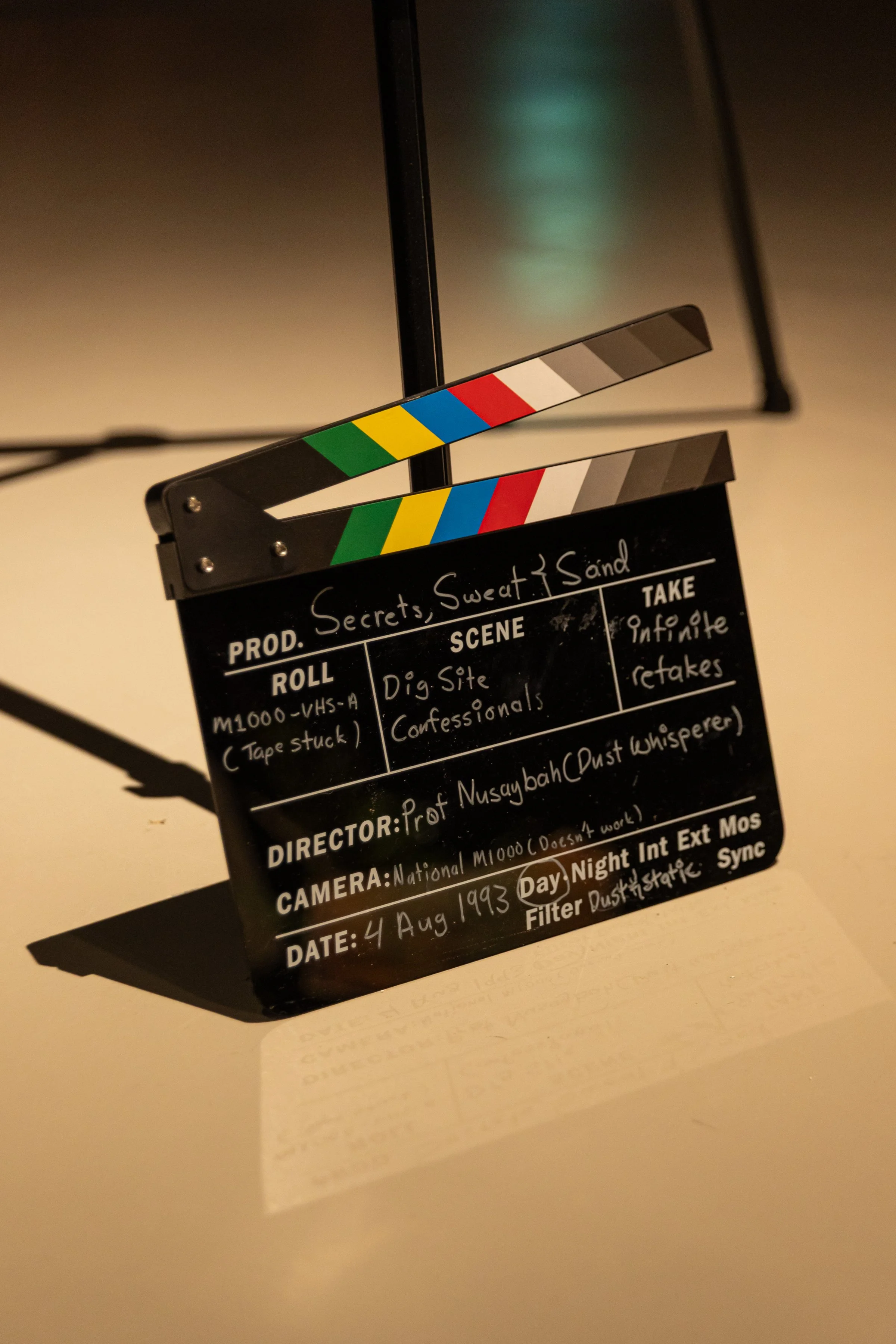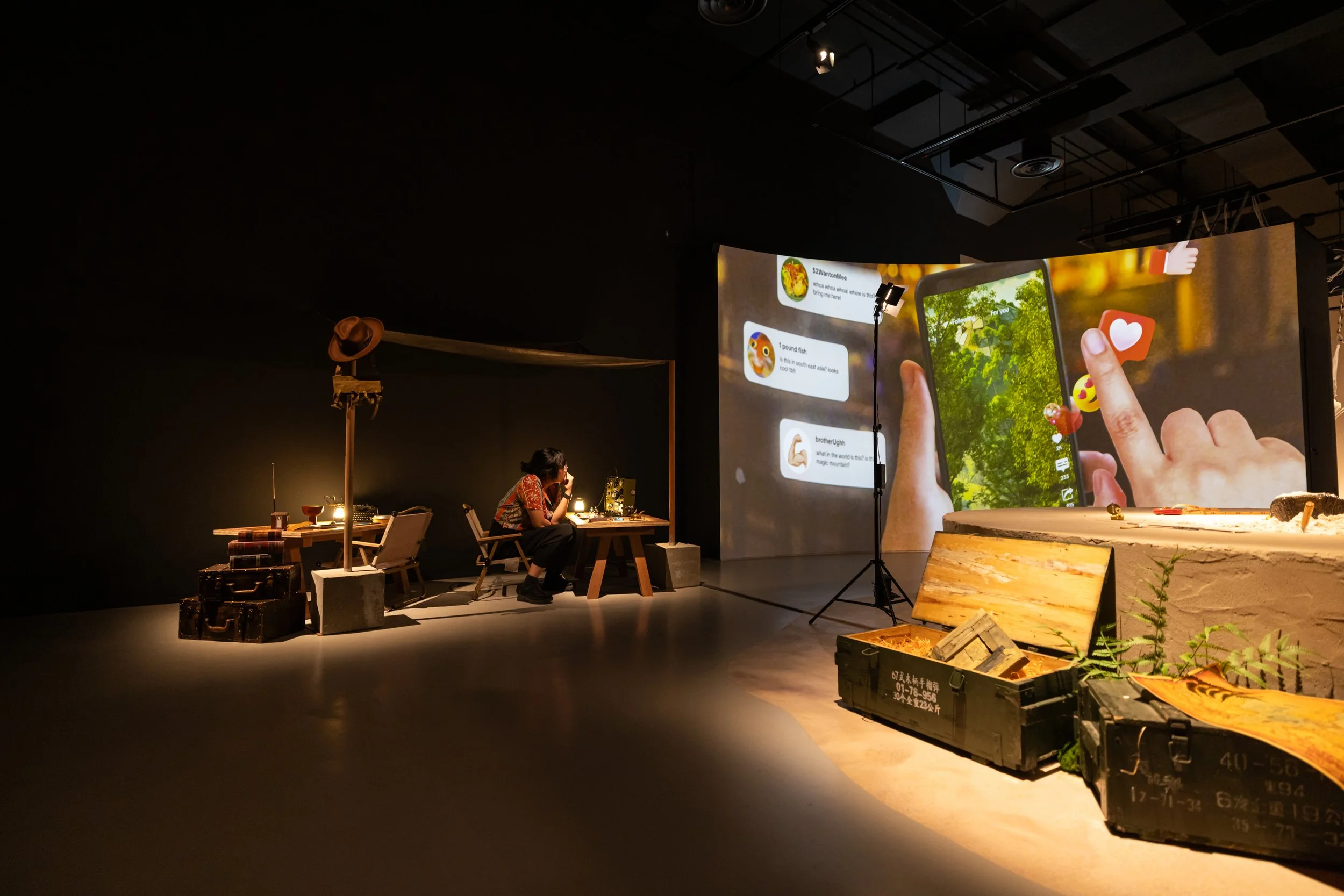In Conversation with NEO_ARTEFACTS
image credit: Courtesy of Singapore Art Museum
Fazleen Karlan (b. 1993) is an artist whose practice lies at the intersection of art-making and archaeological methods. She makes works under the auspices of NEO_ARTEFACTS, an experimental initiative that investigates the intersection between art and archaeology. Drawing on Fazleen’s experience as a post-excavation technician, NEO_ARTEFACTS seeks to reassemble fragments of material from different timeframes to construct personal and cultural realities. Growing up as a millennial, NEO_ARTEFACTS also draws from a variety of influences including internet culture.
NEO_ARTEFACTS has presented solo showcases such as d3ar succ3ss0r (2022) at the Esplanade Community Wall and has participated in several group exhibitions including OH! Open House Kampong Gelam: Palimpsest (2024), Between the Living and the Archive (2021) at Gillman Barracks and Time Passes (2020) at National Gallery Singapore. In 2022, NEO_ARTEFACTS was artist-in-residence at the NTU Centre for Contemporary Art.
I had the pleasure of asking NEO_ARTEFACTS about the techniques and materials they used in Secrets, Sweat, and Sand, why she chose them, and whether it was an emotional connection or a thought-out conclusion that guided her choices, and so much more.
UZOMAH: Your latest work is being featured in SAM Contemporaries: How To Dream Worlds. How did that come about? How did you prepare for this project? What about the project filled you with anticipation and made it special?
NEO_ARTEFACTS: My involvement in SAM Contemporaries emerged from continuous inquiry and discussions with the curators about how my practice engages with archaeology and materiality. The preparations included delving into both the material and conceptual dimensions of the work—revisiting the movies and documentaries to analyse their aesthetics and visual language and considering how they might interact with the gallery space.
To underscore the collaborative nature of archaeological work, I worked with three other artists on the installation. Izzad Radzali Shah created the stone placed in the excavation pit; WALL WORKS contributed a concrete fragment tucked inside a wooden chest; and WAN G designed the motion graphics that formed the visual environment of the installation. This was also integral, as multiple voices expanded the work, opening up possibilities beyond my perspective.
This work was special because of the sense of transformation it carried. I wanted the audience to enter what seemed to be an archaeological site on the surface, but as they go along, that illusion gradually unravels. The anticipation came from seeing ideas coalesce into a tangible installation, which was an invitation to consider how narratives frame our understanding and to question what we accept as legitimate discoveries.
Detail view of NEO_ARTEFACTS’s Secrets, Sweat and Sand as part of SAM Contemporaries: How To Dream Worlds at SAM at Tanjong Pagar Distripark. Image courtesy of Singapore Art Museum.
U: What techniques or materials do you use in Secrets, Sweat and Sand, and why did you choose them? Is it an emotional connection or a thought-out conclusion that guides your choice?
N: Secrets, Sweat and Sand is an assemblage of fabricated artefacts, found objects, sculptural elements, and digital media. The installation stages a speculative archaeological dig at Gunong Perandaian to question how we construct truth from the visual language of belief. The intention is to blur the lines between fact and fiction—not to confuse, but to show how easy it is to believe in something when it is wrapped in the right visual language. It is also about how meaning is conferred when objects are presented in a familiar setting.
The choice of materials was deliberate. I wanted tangible objects to anchor the speculative dig. At the same time, digital elements shaped the atmosphere and worldbuilding, creating multiple layers for viewers to experience and test their assumptions of what archaeology should look like. Popular media portrays archaeology as a heroic adventure with dramatic digs in remote locations, hidden treasures, and ancient traps. But real archaeology is much more complex because excavation constitutes a small part of the work. Much of archaeology also happens elsewhere—in labs, archives, or through community engagement and conservation. It is meticulous, slow, and deeply collaborative. Secrets, Sweat and Sand mirrors that contrast by offering the spectacle of a dig site while exploring how the spectacle can overwrite complexity.
Detail view of NEO_ARTEFACTS’s Secrets, Sweat and Sand as part of SAM Contemporaries: How To Dream Worlds at SAM at Tanjong Pagar Distripark. Image courtesy of Singapore Art Museum.
U: In what ways does your past experience as a post-excavation technician play a part in your artistic practice and vision?
N: My time as a post-excavation technician has deeply influenced how I think about material culture. Much of the work revolved around processing artefacts from the 2015 Empress Place excavation. They were sorted according to material categories or vessel parts. The other aspect was accessioning pieces that were large enough for further study. These tasks formed part of a much longer chain of labour, one that ultimately enabled another person to interpret the material and publish their findings.
Initially, every ceramic shard appeared indistinguishable, and the sheer volume of the artefacts was daunting. Over time, I learnt to differentiate them and came to appreciate the patience and rigour required for post-excavation work. Archaeology is more than unearthing artefacts in the field; the processes that follow—often far more time-consuming—are just as crucial. This side of the work is rarely represented in popular media, yet it is where much of the real understanding takes place.
This experience continues to anchor the way I engage with materiality in my practice. It has taught me that overlooked fragments, textures, and spatial traces can hold immense interpretive weight. In this way, the practice embodies the tension between fact and fiction, spectacle and meticulous labour.
Installation view of NEO_ARTEFACTS’s ‘Secrets, Sweat and Sand’ as part of ‘SAM Contemporaries: How To Dream Worlds’ at SAM at Tanjong Pagar Distripark. Image courtesy of Singapore Art Museum.
U: How did your experience as an Artist-in-Residence with NTU Centre for Contemporary Art impact your practice? Did you further tease out or develop ideas from your experience then through SAM Contemporaries?
N: My residency at NTU Centre for Contemporary Art in 2022 was a formative moment in my practice. It provided dedicated time and space to explore how archaeology is represented in movies and to reflect on the responses such portrayals evoke. The environment encouraged experimentation without pressure, allowing me to consider how my work could shift across materials and contexts. Together with Izzad and WAN G, this led to the creation of Obat Batu, where traditional medicinal objects were presented alongside an origin story, echoing how artefacts are often framed in cinematic narratives.
Through SAM Contemporaries, these explorations were extended, particularly my interest in the visual language of archaeology, while also thinking more broadly about collaboration and the communal aspects of making. These inquiries were instrumental in refining that balance of material assemblage with the creation of immersive environments. In Secrets, Sweat and Sand, the curators supported me as I traced the tensions between fact and fiction: What makes a site feel “ancient”? Why are some places preserved while others are forgotten? And how does media shape our expectations of what we think the past should look like? The process of borrowing from fiction and cinema made those tensions visible. Additionally, presenting an excavation with its mythology highlights how narratives and visual language influence our understanding of archaeology.
U: What made you want to become an artist? What is the most significant advantage of being an artist, and can you name the pivotal point that made you choose art?
N: The path towards being an artist was less a single decisive moment than a gradual unfolding over time. I was drawn to the process of making and reimagining—seeing potential in fragments, objects, or ideas and reshaping them into something new. The pivotal moment came when I realised that art could create meaning, ask questions, and open a space for dialogue. It became a way to weave together curiosity, research, and lived experience into a practice of exploration.
To me, the greatest advantage of being an artist is the capacity to follow threads of curiosity wherever they lead without fixating on arriving at a clear answer. It also offers a kind of resilience—being able to transform ambiguity and tension into something that can live outside of me and speak to others. In this way, art becomes both a personal inquiry and a shared medium to navigate and give form to the uncertainties of life.
U: What does art say visually that the written and spoken word cannot?
N: Art functions through presence, form, and sensation, often circumventing linear explanation to engage the body and affect perception directly. Where language relies on sequence and logic, visual and material practices can accommodate multiple viewpoints at the same time. They convey elements in ways that words cannot, revealing the limits of language in capturing these sentiments.
It also mediates gestures toward memory, grief, or wonder and negotiates the complexities of the world we live in today. In doing so, art does more than communicate—it frames and interrogates the conditions of our understanding. By giving shape to what resists articulation, art invites viewers into an interpretive and relational encounter, rather than a prescriptive one.
U: When you create, where do you draw your greatest inspiration from? What unique perspective drives your creative process? How do you stay innovative in your creative practice?
N: My inspiration comes from archaeology and its methods of uncovering and interpreting fragments of the past. I don’t see them as puzzles to be solved but as openings into other ways of seeing. Objects and residues can carry meaning, and I often ask: what will archaeologists excavate 3,000 years from now? That frame of reference guides a significant portion of my practice.
My perspective is rooted in moving between artistic and archaeological approaches. This dual lens, both critical and imaginative, guides my process. I often work with materials such as stone or soil alongside archival or historical threads, allowing connections to emerge. At its core, my practice is driven by the belief that art can bridge the past and present, personal and collective, and material and digital.
Innovation comes from treating art-making as a form of excavation in itself: peeling back layers and reassembling them again. Archaeology captivates me because of its vastness—it encompasses objects, sites, methods, and histories, offering endless layers to explore. I try to keep my practice porous by including other voices in the work, whether through materials or different ways of thinking. This allows the outcome to remain fluid and communal, rather than fixed in a single standpoint.
U: Can you explain the origin of your name and why you chose to go by it?
N: As of late, I have been exhibiting my works under the name NEO_ARTEFACTS. The term “neo” speaks to reinterpretation, while “artefacts” refers to material culture, the tangible traces that carry stories and meaning across time. Together, the name reflects my interest in engaging with the past through a contemporary lens, exploring how fragments can be reassembled into other forms.
It can be thought of as a practice that transcends my individual authorship and continues to evolve. Archaeology remains a guiding influence, but the practice foregrounds the act of discovering, interpreting, and imagining alongside others as well. The name embodies these multiple aspects and communicates not only what I work with but also how I approach it. In this way, NEO_ARTEFACTS serves as a framework through which past and present resonate together, offering encounters that are living, layered, and generative.
For more information about NEO_ARTEFACTS’s artwork and future projects, please visit her site here. They can also be found on Instagram.



